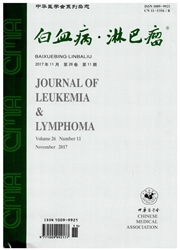

 中文摘要:
中文摘要:
目的研究非血缘双份脐血移植(DUCBT)的植入规律及植入动力学。方法选择接受DUCBT的血液病患者29例,采用复合扩增荧光标记短串联重复序列结合聚合酶链反应(STR—PCR)方法对供受者16个特异性等位基因进行定量分析,了解造血细胞嵌合体动态变化,判断植入情况,研究DUCBT植入规律。同时,通过对两份脐血复苏后有核细胞总数(TNC)、CD^34+细胞数、CD^3细胞数和NK细胞数、冷冻前集落形成单位(CFU)和粒-巨噬细胞集落形成单位(CFU—GM)进行分析,研究植入份脐血的植入动力学和植入份脐血的特点。结果29例患者中,23例获得植入,其中22例为单份脐血的优势植入,1例为两份脐血的均势植入。22例单份脐血优势植入者中,20例移植后14d、另2例移植后21dSTR—PCR检测呈100%单份脐血嵌合体;6例未获得植入的患者,移植后14dSTR-PCR显示2例呈双份脐血嵌合体,4例呈双份脐血或单份脐血与受者混合嵌合体,移植后21d外周血和移植后30d骨髓均呈100%受者嵌合体。DUCBT后7dSTR—PCR检测结果与是否植入不一致(kappa=0.112,P=0.198),14、21d外周血和30d骨髓标本均一致(kappa=0.811,P=0.001;kappa=0.900,P=0.001;kappa=0.900,P=0.001)。DUCBT获得植入患者植入份与非植入份脐血相比,复苏后TNC、复苏后CD^34+细胞数、冷冻前CFU、冷冻前CFU—GM、复苏后CD^3+细胞数、复苏后NK细胞数差异均无统计学意义(P=0.783、0.455、0.615、0.534、0.114、0.463)。结论采用STR.PCR技术检测供受者16个特异性等位基因的定量分析方法确定DUCBT后的植入状态是敏感和特异的,DUCBT后14d可作为确定脐血是否植入的时间。DUCBT中优势植入份脐血的特点仍不清楚,需进一步研究。
 英文摘要:
英文摘要:
Objective To study the discipline of implantation and implantation dynamics in unrelated double umbilical cord blood transplantation (DUCBT). Methods Twenty-nine patients with hematologic malignancies who undergoing two-units unrelated donor cord blood transplantation were included in the study. After transplantation, hematopoietie chimerism of peripheral blood was evaluated by the results of short tandem repeat with polymerase chain reactions (STR-PCR) which quantitatively determinated 16 specific alleles between donor and receptor, to find out their ehimerism dynamic change, to judge whether transplantation was implanted and judge which one was implanted, and to study the discipline of implantation in DUCBT. At the same time, total nucleated eells(TNC), dose of CD^34+ cells, colony forming unit(CFU), colony forming unitranulocyte and maerophage(CFU-GM), dose of CD^3+ cells, dose of natural killer(NK) cells were compared between dominant units and non-dominant ones, to quest the discipline implantation dynamics of DUCBT. Results In 29 clinical cases, 23 cases obtained engraftment, including 22 eases appearing one unit cord blood engraftment and 1 case appearing two units cord blood engraftment. Of 22 cases with one dominant unit engraftment, at 14 days after DUCBT, the results of STR-PCR showed that 20 cases appeared one dominant unit engraftment,other 2 cases appeared one dominant unit engraftment at 21days alter DUCBT. Of 6 cases without engraftment, at 14 days after DUCBT, 2 cases showed chimerism of two units cord blood, other 4 cases showed chimerism of two units cord blood or one unit cord mixed with receptor. At 30 days after DUCBT, their STR-PCR results of bone marrow showed full donor chimerism. Compared results at day 7, day 14, day 21 by peripheral blood, and day 30 by bone marrow with results of implantation after DUCBT, their coherence were kappa=0.112,P=0.198,kappa =0.811,P =0.001,kappa = 0.900,P =0.001 and kappa =0.900, P =0.001, respectively. In addition, compared domi
 同期刊论文项目
同期刊论文项目
 同项目期刊论文
同项目期刊论文
 期刊信息
期刊信息
